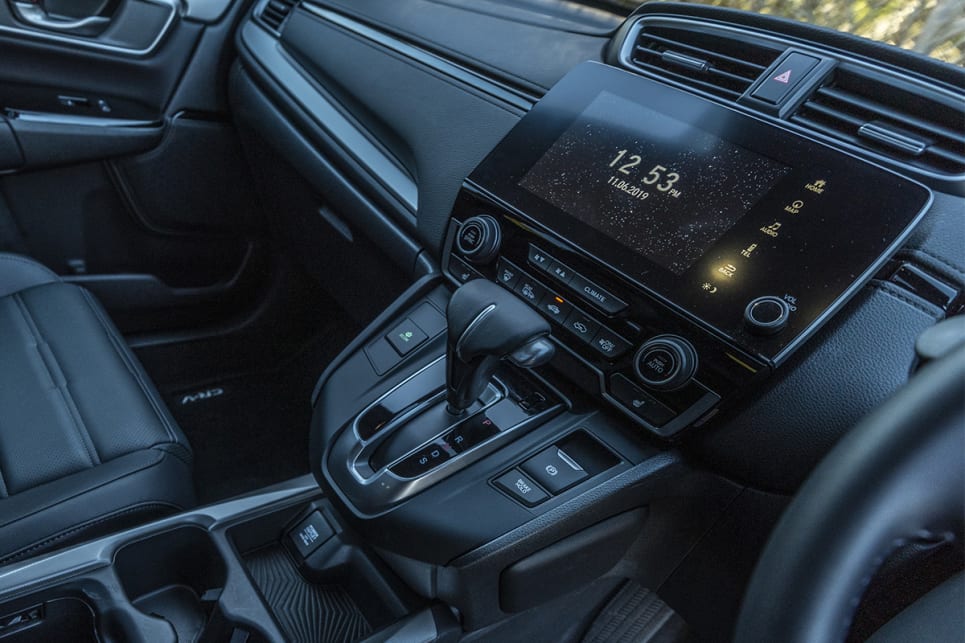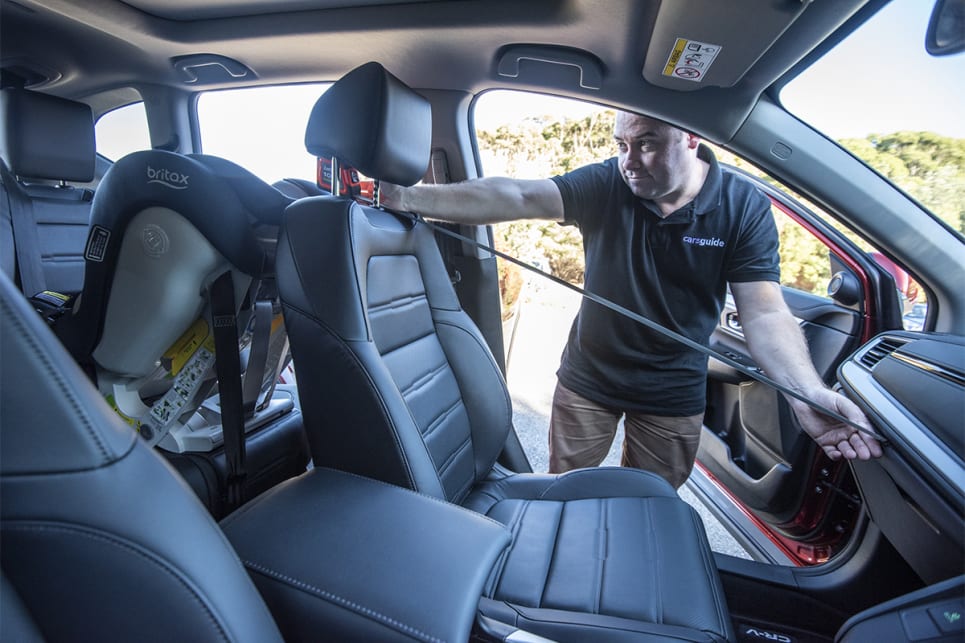We put these four SUVs through their paces with luggage, a pram, baby seats, adults, cups and bottles and more - and there were two models that stood out for outright practicality.
All four models featuring the expected standard inclusions of a touchscreen media system with smartphone mirroring (remember, Toyota says Apple CarPlay and Android Auto will be offered on the RAV later in 2019, and people who buy one before then will be able to retrofit the tech at no cost).
The usability of the systems varies, though. The Honda’s screen doesn’t only control media, it also manages the climate control - temperature and fan speed can be adjusted using the knobs, but the mode and air direction are done through the screen. Weird. Also, the sat nav maps are childish, and the screens take a long time to load.
The Mazda’s screen has the option of touch capacity at a standstill, or rotary dial at speed. Everyone on test liked the addition of a rotary controller, though the Mazda’s screen can be slow to get going, too.
-
 The Honda's sat nav maps are childish, and the screens take a long time to load. (image credit: Dean Johnson)
The Honda's sat nav maps are childish, and the screens take a long time to load. (image credit: Dean Johnson)
-
 The Mazda’s screen has the option of touch capacity at a standstill, or rotary dial at speed. (image credit: Dean Johnson)
The Mazda’s screen has the option of touch capacity at a standstill, or rotary dial at speed. (image credit: Dean Johnson)
-
 The Toyota’s screen is easier to navigate through than we’ve seen from the brand in the past. (image credit: Dean Johnson)
The Toyota’s screen is easier to navigate through than we’ve seen from the brand in the past. (image credit: Dean Johnson)
-
 The Subaru's screen offers the best responsiveness, the best clarity, the best resolution and the most logical menus and controls. (image credit: Dean Johnson)
The Subaru's screen offers the best responsiveness, the best clarity, the best resolution and the most logical menus and controls. (image credit: Dean Johnson)
The Toyota’s screen is easier to navigate through than we’ve seen from the brand in the past - and quicker to load, too. But there are still some buttons that are smaller than they should be, though it’s second best overall here.
But the best screen of this mix is the Subaru - it offers the best responsiveness, the best clarity, the best resolution and the most logical menus and controls. It’s almost the best in the entire class (we’d say the VW Tiguan’s system just beats the Forester).
As for cabin design, we liked the rugged elements of the RAV4 (those awesome rubberised knobs, dials and handles) and Forester (with its chunky, purposeful design), while the CR-V’s simple yet elegant look helped it feel a touch more upmarket than those two. But the best for perceived quality and presentation is the CX-5, which was the most expensive feeling inside. And, well, it is the most expensive, so I guess it should.
-
 Like its exterior, the interior of the RAV4 has rugged elements. (image credit: Dean Johnson)
Like its exterior, the interior of the RAV4 has rugged elements. (image credit: Dean Johnson)
-
 Three adults can fit in the back of the RAV4, which is third best for comfort. (image credit: Dean Johnson)
Three adults can fit in the back of the RAV4, which is third best for comfort. (image credit: Dean Johnson)
-
 The Forester also has a rugged interior. (image credit: Dean Johnson)
The Forester also has a rugged interior. (image credit: Dean Johnson)
-
 The best application of a large sunroof here is the Subaru, because it barely eats into headroom because of the car’s high ceiling. (image credit: Dean Johnson)
The best application of a large sunroof here is the Subaru, because it barely eats into headroom because of the car’s high ceiling. (image credit: Dean Johnson)
-
 The CR-V’s simple yet elegant design helped it feel a touch more upmarket. (image credit: Dean Johnson)
The CR-V’s simple yet elegant design helped it feel a touch more upmarket. (image credit: Dean Johnson)
-
 The Honda was by far the most comfortable across the cabin. (image credit: Dean Johnson)
The Honda was by far the most comfortable across the cabin. (image credit: Dean Johnson)
-
 The CX-5 feels the most expensive inside. (image credit: Dean Johnson)
The CX-5 feels the most expensive inside. (image credit: Dean Johnson)
-
 The Mazda offered the worst rear seat comfort. (image credit: Dean Johnson)
The Mazda offered the worst rear seat comfort. (image credit: Dean Johnson)
All four have cup holders in the centre console and in the backseat armrest, and all have bottle holders in their doors. But for cabin storage, the CR-V’s enormous and configurable centre console bin is a treat, and the Forester’s double map pockets are great, too. The Toyota only has one map pocket in the back, which is weird and inconvenient.
All four have rear USB ports to keep the kids quiet on trips - but the Mazda’s are mounted in the centre armrest, which could deem them useless depending on how full the car is. The others have USBs mounted in back of the centre console section, where you’ll find air vents in all of these models.
Resident dad, Mal Flynn, fitted a rear-facing 0-4 child seat to the back left position of each car - you know, the configuration used for about the first 12 months of driving around with bub - and measured the maximum allowable distance from the front seat (at a comfortable recline angle) to the leading edge of the dashboard. This gives you an indication of how much adult space remains up front, which no doubt surprises many when fitting a child seat for the first time.
Despite being similar in overall size, there was a full 10cm of space between the space allowed in the CR-V (best) and CX-5 (worst). This was the difference between being very uncomfortable with my knees pressed up against the dash (for my 182cm frame), and comfortable space with room to spare.
-
 A rear-facing 0-4 child seat was fitted to the back left position of each car. (image credit: Dean Johnson)
A rear-facing 0-4 child seat was fitted to the back left position of each car. (image credit: Dean Johnson)
-
 The RAV4 has rear doors that don’t open up to 90 degrees - meaning loading children or baby seats in the second row is difficult. (image credit: Dean Johnson)
The RAV4 has rear doors that don’t open up to 90 degrees - meaning loading children or baby seats in the second row is difficult. (image credit: Dean Johnson)
-
 Despite being similar in overall size, there was a full 10cm of space between the space allowed for an adult in the CR-V (best) and Mazda CX-5 (worst) with a child seat fitted behind. (image credit: Dean Johnson)
Despite being similar in overall size, there was a full 10cm of space between the space allowed for an adult in the CR-V (best) and Mazda CX-5 (worst) with a child seat fitted behind. (image credit: Dean Johnson)
-
 The CR-V is very family friendly. (image credit: Dean Johnson)
The CR-V is very family friendly. (image credit: Dean Johnson)
-
 With a baby seat fitted, the Mazda once again offered the worst space. (image credit: Dean McCartney)
With a baby seat fitted, the Mazda once again offered the worst space. (image credit: Dean McCartney)
-
 The CX-5 is letdown by its chunky doors. (image credit: Dean Johnson)
The CX-5 is letdown by its chunky doors. (image credit: Dean Johnson)
-
 The Forester was 5cm shorter than the CR-V, placing it third in the group. (image credit: Dean Johnson)
The Forester was 5cm shorter than the CR-V, placing it third in the group. (image credit: Dean Johnson)
-
 The Forester has wide opening rear doors. (image credit: Dean Johnson)
The Forester has wide opening rear doors. (image credit: Dean Johnson)
The RAV4 was second best in this regard, giving up just 2cm to the CR-V, with the Forester in third at 5cm shorter, but both were sufficient compared to the CX-5.
All four of these SUVs will fit three adults - or two child seats and a baby seat - across the back pew, but the levels of comfort varies. Our width testing trio - myself, Jarryd Sullivan and Mal Flynn - found the Honda was by far the most comfortable across the cabin, with the Subaru again close behind. The Toyota was third best, and - you guessed it - the Mazda was worst, let down by its chunky doors. The legroom was also worst in the Mazda, and in the Honda the rear seating position was a bit too 'knees-up' for taller adults. The Toyota and Subaru were about equal for leg room, with enough for someone my height (182cm) to sit comfortably behind an identical size person.
The best application of a large sunroof here is the Subaru, because it barely eats into headroom because of the car’s high ceiling.
The Mazda’s sunroof is small, and therefore doesn’t interrupt the space much - but it’s also the worst for overall space, so it does feel like it’s impinging on the cabin more than it actually does.
The Toyota’s sunroof is on the small side, too (you can get a bigger panoramic roof, but only in the range-topping Edge non-hybrid model), but it doesn’t impact the space too much.
Boot space details are below:
| | Honda CR-V
VTi-LX | Mazda CX-5 GT
2.5 Turbo | Toyota RAV4
Cruiser Hybrid | Subaru Forester
2.5i-S |
Boot capacity -
five seats up | 522 litres VDA | 442 litres VDA | 580 litres VDA (low
floor height) | 498 litres VDA |
Boot capacity -
two seats up | 1084 litres VDA (to window) | 1342 litres VDA (to roof) | N/A | 1768 litres VDA (to roof) |
Rear seat folding
mechanism | Boot and seat-mount levers | Boot and seat-mount levers | Seat-mount levers only | Electric boot triggers and seat-mount levers |
Rear seat folding
ratio | 60:40 | 40:20:40 | 60:40 | 60:40 |
For interior and practicality, the Honda and Subaru come out on top. They offered the best levels of medium SUV pragmatism and thoughtfulness, with the RAV4 just behind. The Mazda is smaller inside, and suffers a little in this section of the test as a result - despite having the most premium cabin look and feel.
Check out the images of the boot space to see the differences between each of the cargo zones - we got images of the pram and the suitcases in each of these cars to give you a good idea of how they really stack up.
-
 With the rear seats in place, the RAV4 has 580 litres of cargo space. (image credit: Dean McCartney)
With the rear seats in place, the RAV4 has 580 litres of cargo space. (image credit: Dean McCartney)
-
 Even with a pram in the back, the RAV4 has space to spare. (image credit: Dean McCartney)
Even with a pram in the back, the RAV4 has space to spare. (image credit: Dean McCartney)
-
 Holding three suitcases isn't a problem for the RAV4. (image credit: Dean McCartney)
Holding three suitcases isn't a problem for the RAV4. (image credit: Dean McCartney)
-
 With the rear seats in place, the CR-V has 522 litres (VDA) of boot space. (image credit: Dean McCartney)
With the rear seats in place, the CR-V has 522 litres (VDA) of boot space. (image credit: Dean McCartney)
-
 The CR-V easily swallowed our three suitcases. (image credit: Dean McCartney)
The CR-V easily swallowed our three suitcases. (image credit: Dean McCartney)
-
 Fitting a pram in the back of the CR-V wasn't a problem. (image credit: Dean McCartney)
Fitting a pram in the back of the CR-V wasn't a problem. (image credit: Dean McCartney)
-
 Cargo space in the CX-5 is rated at 442 litres VDA. (image credit: Dean McCartney)
Cargo space in the CX-5 is rated at 442 litres VDA. (image credit: Dean McCartney)
-
 While the pram fits in the back, it takes up the majority of space. (image credit: Dean McCartney)
While the pram fits in the back, it takes up the majority of space. (image credit: Dean McCartney)
-
 The Mazda offers the least among of rear storage. (image credit: Dean McCartney)
The Mazda offers the least among of rear storage. (image credit: Dean McCartney)
-
 Boot space in the Forester is rated at 1768 litres VDA. (image credit: Dean McCartney)
Boot space in the Forester is rated at 1768 litres VDA. (image credit: Dean McCartney)
-
 The Forester has one of the bigger boots in this group. (image credit: Dean McCartney)
The Forester has one of the bigger boots in this group. (image credit: Dean McCartney)
-
 Even with three suitcases on board, the Forester still has boot space for other things. (image credit: Dean McCartney)
Even with three suitcases on board, the Forester still has boot space for other things. (image credit: Dean McCartney)
| Model | Score |
| Honda CR-V VTi-LX | 9 |
| Mazda CX-5 GT 2.5 Turbo | 7 |
| Toyota RAV4 Cruiser Hybrid | 8 |
| Subaru Forester 2.5i-S | 9 |





























































 Haval Jolion
Haval Jolion